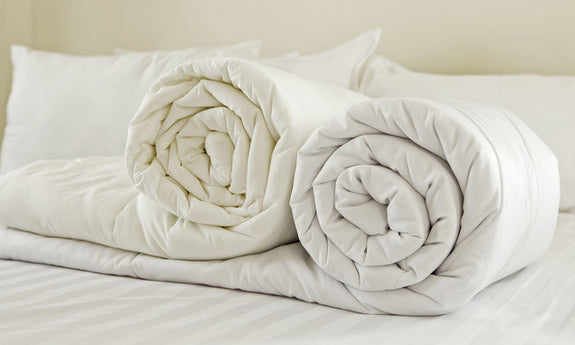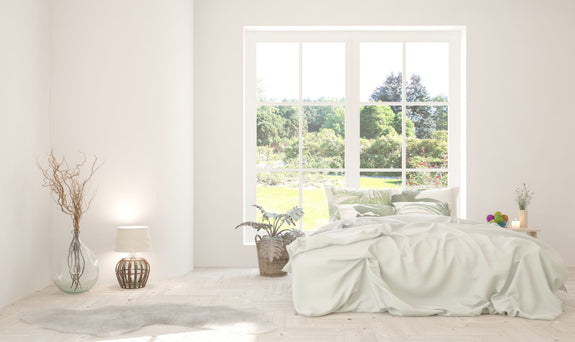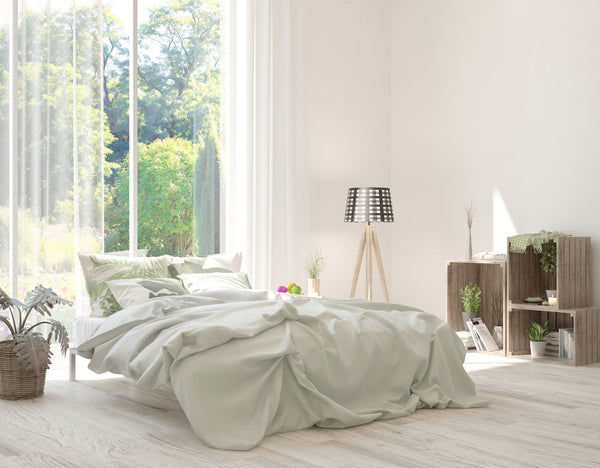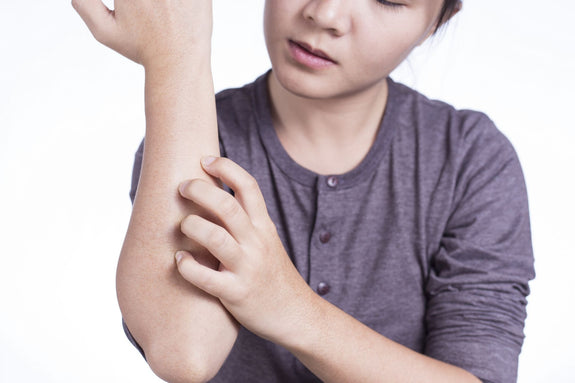
The Ultimate Guide to Buying a Quilt
How often do you wake up feeling cold, restless, exhausted, or uncomfortable?
With sleep accounting for approximately 227,000 hours of our lives and a major contributing factor to our health - both physical and mental - it's imperative to get the best sleep possible.
This means that your quilt (along with all of your other bedding layers) has a certain degree of impact on your health, and choosing the best quilt for you and your needs will help ensure you optimise your quality of sleep and wake up feeling well-rested.
There are numerous factors involved when deciding on the best quilt in Australia, but we've got an information-packed guide here to make that decision an easy one.
What should I look for when buying a quilt?

Choose the right filling material
Our Fill Materials
A classic filling for a quilt since many years ago, wool is a naturally insulating fibre that steadily regulates your body temperature. Though wool fibres breathe, it is excellent for retaining warmth and is often better suited for cooler temperatures in its heavier-weighted options (500gsm). For warmth without weight, the 150gsm and 350gsm wool options are great for summer and everyday climates respectively.
Alpaca WoolA speciality wool fibre type, alpaca wool is resilient. Because of its high tensile strength, well-treated alpaca wool will last a very long time. Since the fibre absorbs moisture, it can keep you warm and dry in the winter and cool and dry in the summer.
One of the lesser-known fillings for quilts, cotton fibre clusters are durable, light, and a little less insulating than wool. It’s a great choice for cotton lovers who know and love the fibre across all products, from bed sheets to their everyday clothing. Overall, cotton quilts are best suited for warmer climates or hot sleepers.
This filling has become more popular over recent years due to its hypoallergenic and cooling properties. Bamboo fibres are perhaps the most breathable of all the natural fillings. Some consider it the best quilt Australia has to offer! It's also extremely comfortable, lightweight, moisture-wicking, and even anti-bacterial. It'll help keep nasty dust mites, bacteria, fungus, and mould away, which also means lower maintenance and less washing. As it is suited well for warmer & more tropical climates, bamboo quilts are light enough to allow extra layering in colder months for additional warmth.
*MOISTURE WICKING: The fabric is able to pull moisture away from the body and onto the surface of the quilt, making it easier for it to evaporate.
Comfortable and warm but also lightweight with a very lofty sensation, a down quilt is naturally insulating and creates a soft "fluffy" sleeping experience. Feathers are typically mixed into down quilts, but you can also get feather-only designs that have a heavier feel, which costs much less as a budget-friendly option. The warmth and insulating characteristics come from the down, which is most costly to acquire, hence why the higher the ratio of down in these quilts means the warmer it will be (and more expensive). The feather and down quilt is also used by luxury hotels, so if you want to have the same experience as sleeping in a luxury hotel, this is the perfect option.
Goose down VS Duck downAlthough the two are essentially the same in appearance, there are slight size differences in the feather. Duck Down and Feather is slightly larger and heavier in size, while Goose Down and Feather is lighter and smaller with higher insulating properties due to the fibre being slightly more resilient (making it a longer-lasting product). As a result, goose-down quilts are typically warmer and have much more longevity.
Synthetic quilts are man-made designs that can be easily washed for maintenance and feel quite soft and dense. Most are usually budget-friendly and can be made from various materials such as microfibre and polyester. Some synthetic fills can also mimic the qualities of natural fibres, like the Outlast® Fibre, which has thermal regulating capabilities. High-quality synthetic quilts are made from super fine microfibre blended with polyester to create more loft, better breathability, and washability.

The GSM
For quilts in Australia, as well as universally, GSM refers to the quilt filling's weight, meaning "grams per square metre."
As a rule of thumb, a quilt with a higher GSM translates to increased weight, which also usually relates to increased warmth. A higher GSM doesn't necessarily mean the quilt is "better" in terms of quality or durability; it just varies with warmth/density.
If you're in a warm climate or someone with a warm body temperature, aim for a 150-250 GSM quilt. Autumn and Spring invite a 250-400 GSM quilt for better comfort, while 500 GSM and above is best for winter weather and colder climates. In terms of weight, which is a common question, feather and down quilts are the lightest, followed by microfibre quilts. Wool quilts tend to be more traditional feeling slightly heavier and less loft. Bamboo quilts and cotton sit in the middle, weighing less but also looking flatter as they have less loft. Remember that this is only a guide, and that you yourself may prefer to opt for a 200 GSM quilt all year-'round and then add layers like blankets or coverlets as the seasons get cooler. Whatever suits your lifestyle best is entirely up to you!

Quilts according to seasonal preference
Each quilt is unique and can be chosen according to many individual factors, such as the climate and your personal preferences. Quilts are often categorised by seasons by the manufacturers to determine the best time of year for use. If you prefer to shop seasonally, here are some tips:
We have a few summer options depending on your material preference.
WOOL: For the warmer months, we recommend the 150GSM quilt, which is a fairly lightweight option. It is also an excellent choice for those that prefer a flatter quilt with less loft/height.
NATURAL FIBER: We have two choices: BAMBOO and COTTON. For the warmer months, we would recommend the 350GSM (the standard) in both Cotton and Bamboo. As these fibres are the most breathable, a higher fill content means that they will regulate temperature better all year around, including hotter summer months.
SYNTHETIC: For the warmer summer months, we recommend a 250GSM synthetic quilt. And although they feel and look super lightweight for summer, remember that they are synthetic and thus not as breathable as those made from natural fibres. We would only recommend this to anyone who gets cold easily at night and struggles to stay warm with their own body heat.

Again, depending on your preferences, we have several options. These options are also aimed at people who only want one quilt to use all year and use air conditioning to keep their rooms cool in the summer. Suggestions include the following:
WOOL: 500GSM. (equivalent to the warmth of 2-3 blankets).
SYNTHETIC: 500GSM. We would suggest the Hilton 500GSM quilt.
FEATHER AND DOWN: 80% down.

All-season quilts are ideal for all-year-round use. These quilts are ideal for those who only want one quilt all year and are satisfied to layer when temperature decreases and remove layers when temperature increases. There are the following options:
WOOL: 350GSM
SYNTHETIC: 350GSM and 400GSM
FEATHER & DOWN: 50/50 feather and down, 80/20 feather & down mid-warmth

Alternatively, you might be swayed into the higher-end range, which is our FOUR SEASON category of quilts. This is a well-thought-out range of quilts designed for year-round comfort. They are a 2-in-1 system of the quilt, where two quilts can be clipped together for the cooler seasons or unclipped (with only one used) for the warmers months of the year. These two quilts that are included will have varying weights (typically a 40% 60% split) to suit different seasons. This is offered in WOOL as well as FEATHER & DOWN.
The all-seasons quilts are a great solution for you if you and your partner have different sleeper types (hot sleeper vs cold sleeper). This solution allows the partner who feels cold in the winter to layer up on his or her side while their partner does not overheat on the other side.

Anything Else to Consider When Choosing a Quilt
The Loft
The Tog Rating
Environmentally friendly fibres
When it's time to wash your bedding, don't immediately toss your quilt into a washing machine. First, look at the product care label and learn the washing guidelines, as these are unique to every type of quilt. For example - wool quilts are typically dry-cleaned, while synthetic quilts are typically fine to wash in the machine. Machine washing a feather and down quilt can ruin the fill irrevocably - so always do your research first.
We suggest you always use a gentle/delicate cycle with only cold water if you're using a washing machine to clean your quilt. Detergents should be dye-free and perfume-free to prevent staining, and with how large quilts often are, ensure your washing machine is large enough to hold the weight and volume of your quilt when wet. For quilts that cannot be machine washed, we recommend airing them regularly in sunlight to kill bacteria and giving them a light vacuum to remove dust.
This complete quilts Australia guide should set you up with the right knowledge to make the appropriate purchase and, therefore, to enjoy an excellent sleep. If you're after the best quilt Australia can offer, you can't beat our extensive quilt range to meet every need outlined in this article.



























